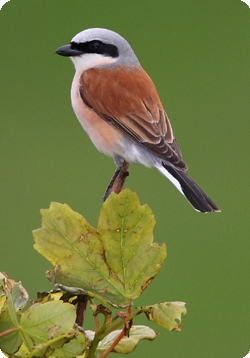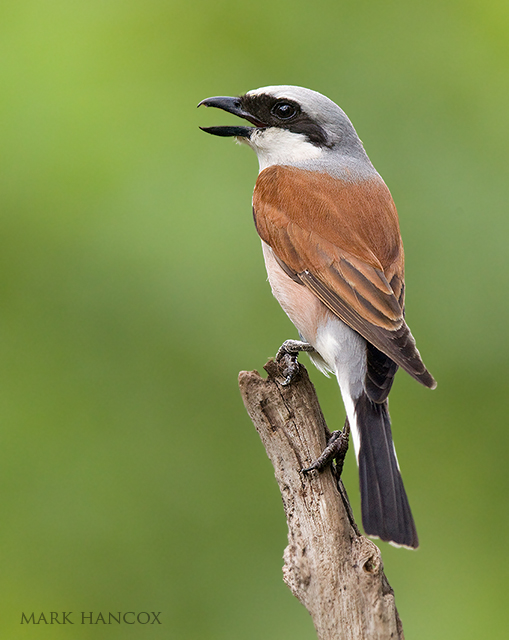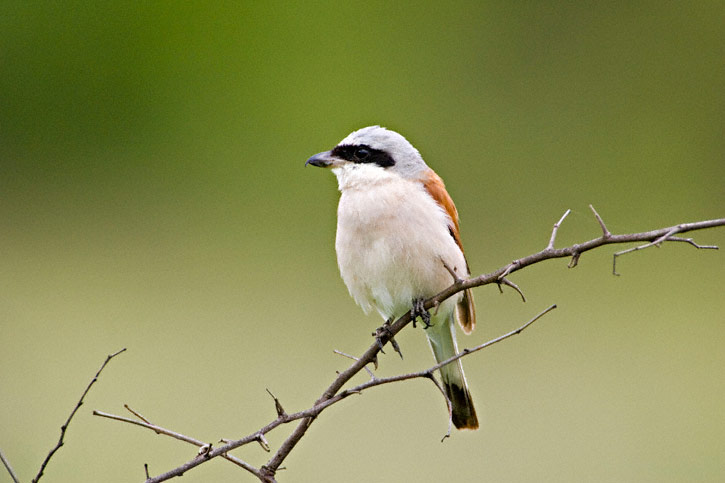
Lanius collurio
SUBFAMILY
Laniinae
TAXONOMY
Lanius collurio Linnaeus, 1758, Sweden. Up to five races described,
but probably best considered monotypic as the supposed
and slight differences between races also occur within
given local populations all over the breeding range.
OTHER COMMON NAMES
French: Pie-griиche йcorcheur; German: Neuntцter; Spanish:
Alcaudon Dorsirrojo.
PHYSICAL CHARACTERISTICS
6.2–7 in (16–18 cm); on average 1.05–1.12 oz (30–32 g). One
of the smallest Lanius shrikes; strong sexual dimorphism. The
brightly colored male is unmistakable with his gray head, reddish
brown upperparts, gray rump, black tail fringed white, and
pinkish underside. Female is much duller, but her ground color
is variable; brown and gray are dominant; her under-parts are
generally heavily vermiculated. Juveniles are very similar to the
female but with strong barring, (black crescents), also on upperparts.
DISTRIBUTION
Most widespread and common shrike in the western Palearctic,
almost reaching the Arctic circle in the north. In some hot
Mediterranean areas, like Spain and southern France, it is regarded
as a bird of low mountains. This long-distance migrant
winters in eastern and southern Africa, from southwestern
Kenya southwards.
HABITAT
Semi-open habitats dotted with low perches and thorny bushes
like hawthorn and blackthorn. Benefits from low-intensity
farming, particularly traditional pastures; also found in young
plantations, forest clearings, etc. Breeds up to about 6,600 ft
(2,000 m) in the French Alps and even up to about 10,500 ft
(3,200 m) on meadows in Caucasus. In Africa, it favors arid savannas
and particularly dry Acacia thornveld.
BEHAVIOR
In breeding season, it defends a rather small territory covering
3.7–7.4 acres (1.5–3 ha). At the end of April or beginning of
May, when they have returned from Africa, perched males advertise
their territories by typical, far-carrying, and somewhat
nasal calls. It is a “sit and wait” predator that takes most of its
prey on the ground; however, many insects are also caught in
the air in fair weather. Larders are kept, but that habit varies
among individuals and is less common in warmer climates,
where insects are plentiful and easier to locate. Leaves its
breeding sites from the beginning of July onward; October observations
are rare in Europe. It is a long-distance and a loop
migrant; in autumn, west European populations converge towards
Greece and its islands before crossing the sea to Egypt,
and then to Sudan and Ethiopia; in spring, these two last countries
are almost completely avoided as the species passes more
to the east, toward the Arabian peninsula.
FEEDING ECOLOGY AND DIET
Arthropods, mainly insects, particularly beetles and grasshoppers.
Small vertebrates constitute about 5% of the captures,
but may even be more important in certain years when moles
are abundant.
REPRODUCTIVE BIOLOGY
Monogamous. Densities can be locally high with up to seven
pairs, almost loose colonies, per 25 acres (10 ha) in good habitats.
Isolated pairs are not rare, however. Nests are built soon
after arrival from wintering quarters at an average height of
about 4.2 ft (1.3 m) above the ground, often in a thorny bush.
In most areas, laying begins at the end of May and peaks in the
first two weeks of June. Second broods are very rare, but replacement
clutches are frequent. Female usually lays four to six
eggs (range one through eight); incubation is 13–15 days exclusively
by female, who is regularly fed by male. Nestling period
is about 15 days. Young are completely independent when they
are about six weeks old.
CONSERVATION STATUS
Not threatened, but declining in many countries, particularly
at lower altitudes where they have been eliminated by the intensification
of agriculture. Climatic fluctuations may also play
a role; has disappeared as a regular breeding bird from Britain,
which lies on the north-western limits of its range.
SIGNIFICANCE TO HUMANS
In Europe, it is now protected and regarded as a significant
bio-indicator of the health of the wider environment. Thousands
still are killed on migration, particularly in Greece and in
the Middle East.
Other popular Animals
Photo Gallery of - Red-backed shrike




 Animalia Life
Animalia Life